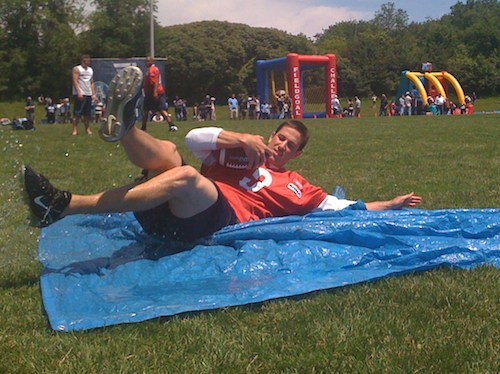Dear Sports Fan,
Why do quarterbacks slide? I guess there’s some rule that you can’t touch the quarterback if he slides with the ball? Seems kind of unfair to me.
Thanks,
Fred
— — —
Dear Fred,
Why do quarterbacks slide? It’s a good question. You’re right that they are taking advantage of a rule when they do slide but it might not be as unfair as you think. We’ll look into the rule, discuss why it is that quarterbacks slide and other positions don’t, and check out a couple creative ways that players really do look to get an advantage out of sliding.
The sliding rule comes from a set of scenarios that end a play in football. In the NFL, that list includes criteria like, “when a forward pass (legal or illegal) is incomplete,”when the ball is out-of-bounds,” and the one that we care about in this post, “when a runner declares himself down by sliding feet first on the ground. The ball is dead the instant the runner touches the ground with anything other than his hands or his feet.” This rule applies equally to all the players on the field, quarterbacks are not special when it comes to sliding. Anyone who has the ball, can at any time for any reason, make the play end by sliding feet forward on to the ground. Once the play is over, of course, no one is allowed to hit the player with the ball unless they’ve already committed irrevocably to the motion of hitting the ball-carrier before the play ended. When we talk about rules on this site, we often end up categorizing them into rules intended to create even and exciting competition and rules intended to create relative safety for a sport’s participants. This one is definitely a safety rule but it has a competitive wrinkle built-in. As opposed to when a player dives forward with the ball, a player that slides feet forwards only advances the ball to the place where they first started their dive. Their team therefore loses out on a territorial advantage if a player decides to slide feet first.
The reason why sliding is commonly thought of as something only quarterbacks can do is because it’s usually something only quarterbacks actually do in practice. Part of this is tactical — there’s often a much greater difference between the starting quarterback and the backup compared to the starting running back or wide receiver and the next one on the team. It’s more harmful for a team to lose a quarterback than virtually any other position. Part of it is also cultural though. It’s simply not accepted for a running back or a wide receiver to voluntarily end a play by sliding the way it is for a quarterback. Quite the contrary, even running backs or wide receivers who run out-of-bounds or dive head first to avoid a hit are looked on slightly askance. As the impact of brain injury becomes more well understood, (and perhaps more importantly for this conversation, the protocols for handling potential brain injuries, because they take players off the field for a time, become more seriously enforced,) this cultural norm about sliding might change.
Some of the leagues craftier quarterbacks still look to get an advantage out of sliding. Not only do they protect themselves but, they think, what else can I get out of this process for my team and me? In Tom Brady’s case he thought, “maybe I can injure (or at least either scare or anger) my opponent while sliding.” So, he slid with his cleats up, like way up… like a baseball player sliding into second trying to cancel out a double-play. That’s a pretty perverse thing to do — to turn a move designed to guarantee one’s own safety into an attack. Smart man. Andrew Luck, quarterback of the Indianapolis Colts seemed to have been working the rules in a preseason game this year when he kind of slid sideways in a rolling kind of movement. Backup quarterback and connoisseur of treachery, Matt Hasselbeck, had this to say about it:
“It was sneaky,” backup quarterback Matt Hasselbeck said through a wry smile. “It wasn’t really a slide and it wasn’t really a dive.
“I thought he was trying to get away with the barrel-roll. I think he was trying to score. (If) nobody tags him down, he gets back up and runs. Watch the film. Genius.”
The slide in football is pretty much a quarterbacks only move now but I think we’ll begin to see that change over the next couple of years. My concern with the sliding rule, as a person with bad knees, has always been that sliding feet first, with cleats on, isn’t actually a safe move even if the rules say it’s safe. It’s way too easy to catch a cleat on the turf and end up with an injured knee. In college football, sliding is unnecessary because any contact with anything but hands or feet when a player has the ball immediately ends the play. That’s a safer rule and it doesn’t steal much excitement from the game at all. Maybe we’ll see that migrate to the NFL in time as well.
Thanks for the question,
Ezra Fischer

